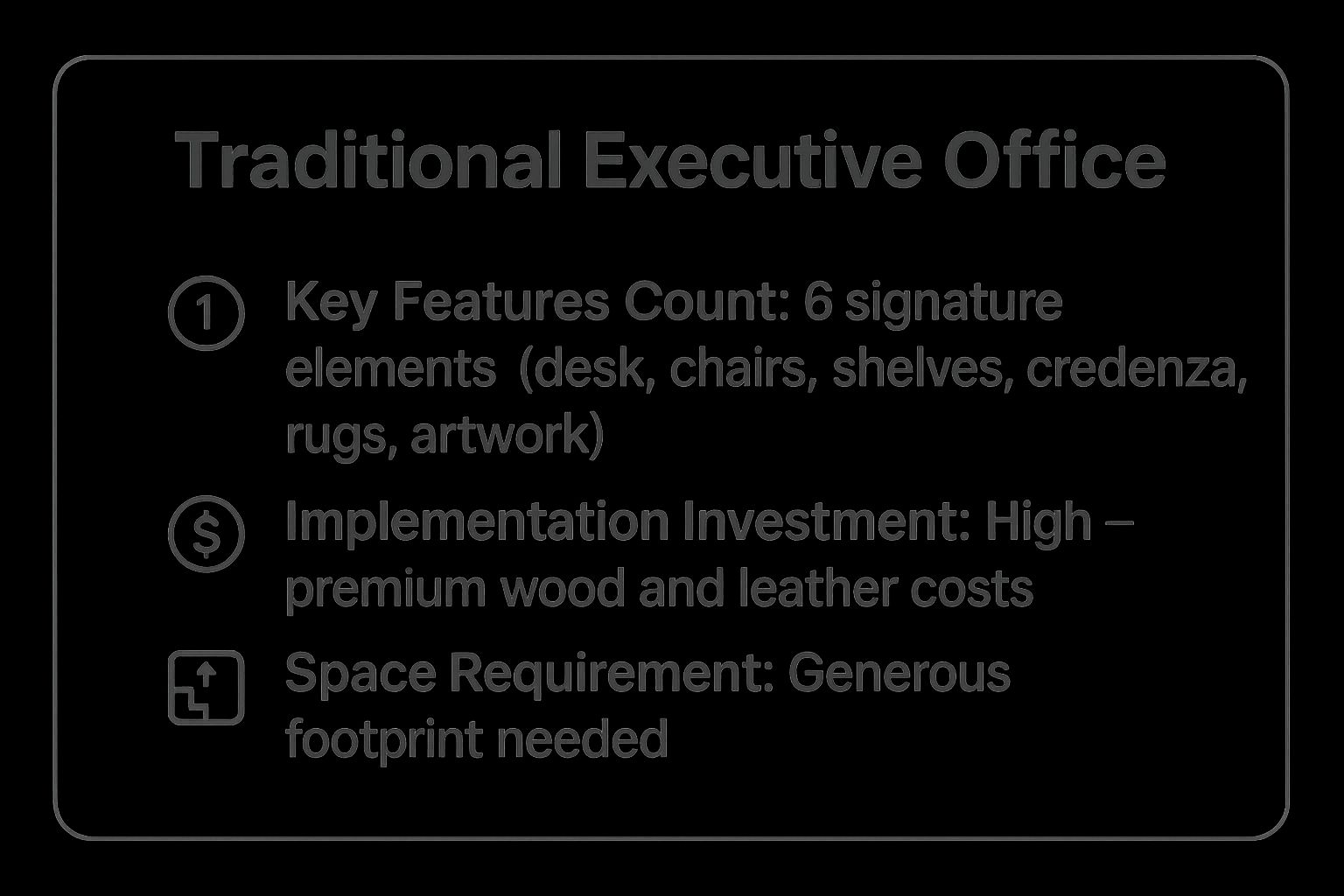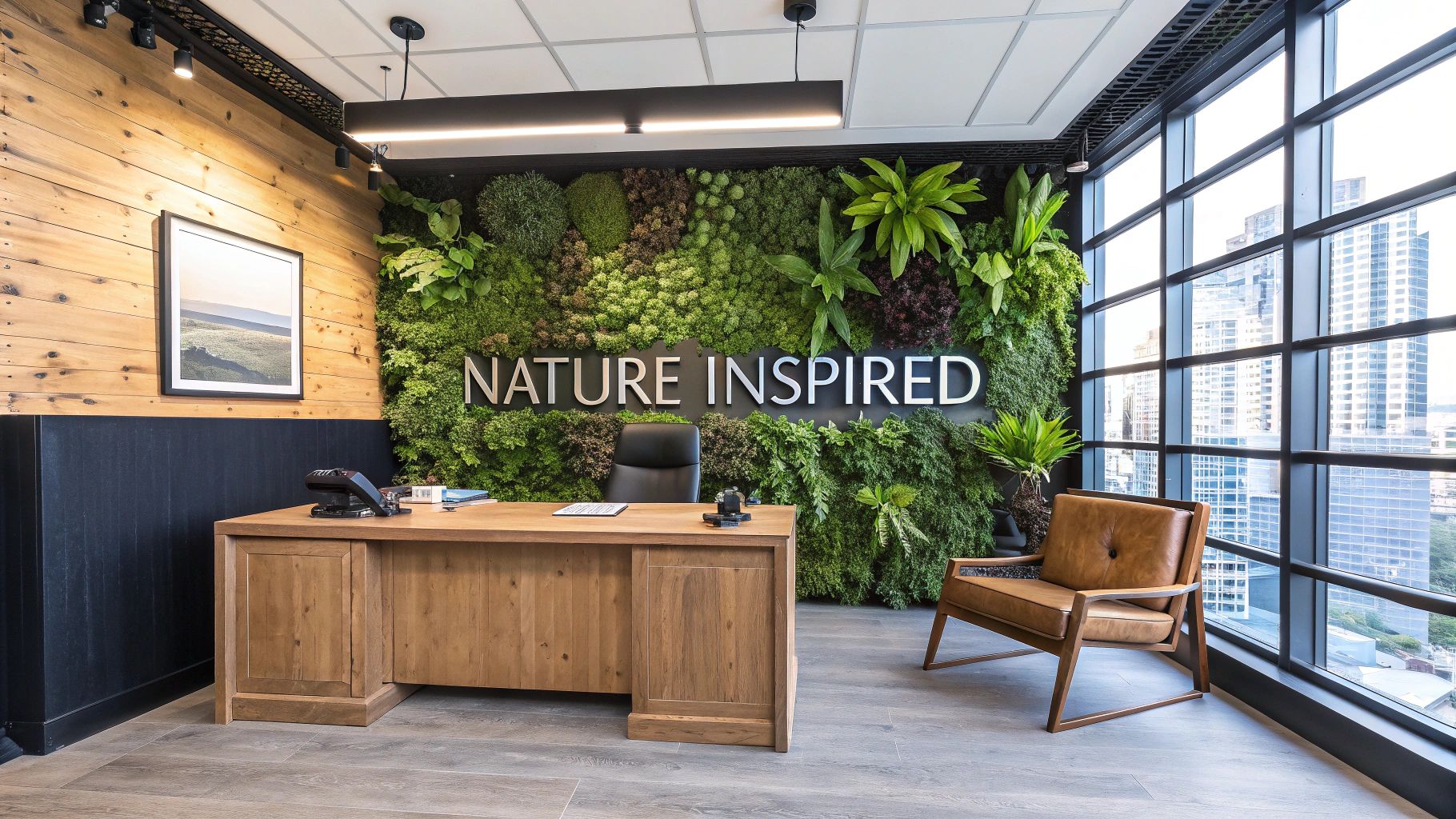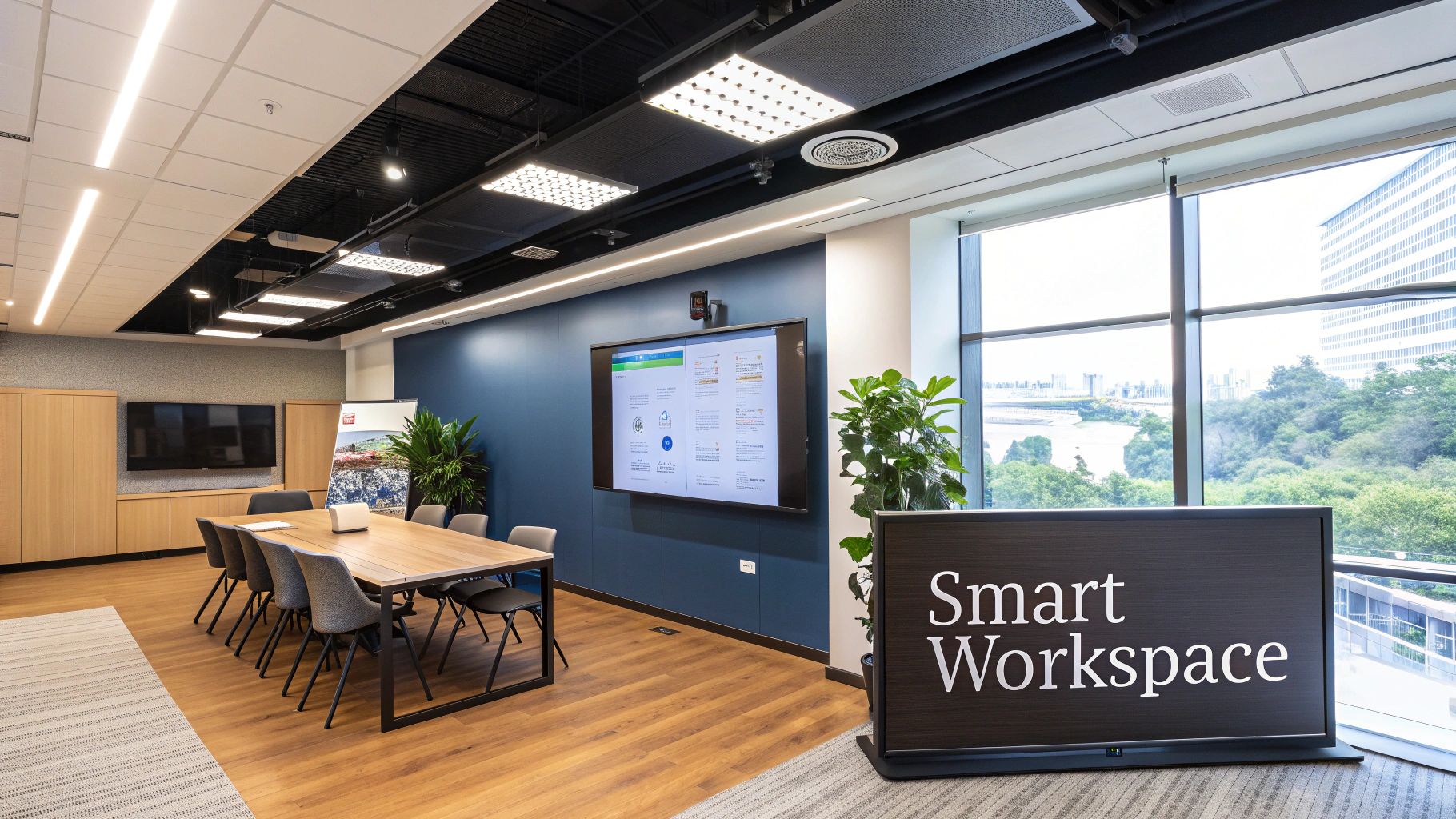9 Game-Changing Executive Office Design Ideas for 2025
Aug 05, 2025
An executive office is more than just a place to work; it's the command center of your enterprise, a reflection of your brand's ethos, and a powerful tool for productivity and influence. In today's competitive landscape, the design of this critical space speaks volumes before you even say a word. Moving beyond generic setups, the modern executive office blends functionality with profound personal and brand expression. Whether you aim to project timeless authority, cutting-edge innovation, or a commitment to wellness, the right design can amplify your message and foster a focused mindset.
This guide presents a curated collection of distinct executive office design ideas, each offering a unique blueprint for creating a space that is not only visually stunning but strategically sound. We will delve into comprehensive concepts covering everything from layout and furniture to advanced technology integration and decor. The goal is to provide actionable insights to help you build an environment that inspires success, solidifies your brand identity, and enhances your daily workflow.
We will explore a range of styles, including:
- Traditional and Modern Minimalist: For classic authority or sleek focus.
- Biophilic and Wellness-Focused: To integrate nature and promote well-being.
- Tech-Forward and Industrial: For showcasing innovation and raw, structural aesthetics.
Each concept provides a complete vision, ensuring you can find the perfect fit for your leadership style. Furthermore, we'll discuss the subtle but impactful role of sensory details, such as integrating a signature scent with a luxury diffuser, which can elevate the atmosphere from merely functional to truly exceptional. Let's explore the blueprint for your ultimate workspace.
1. Traditional Executive Office
The traditional executive office design is a timeless statement of authority, prestige, and enduring professionalism. This classic approach, often seen in high-stakes environments like law firms and investment banks, prioritizes substance and structure. It creates a powerful first impression through rich, dark woods like mahogany or walnut, sumptuous leather seating, and a formal, hierarchical layout that places the executive desk as the clear focal point.
This style isn't just about appearance; it’s about conveying stability and tradition. The core of this design idea lies in its commitment to quality craftsmanship and materials. Think of a stately, commanding desk from a heritage brand like Herman Miller, complemented by button-tufted leather guest chairs and built-in bookshelves filled with leather-bound volumes and curated accolades. The goal is to build an environment that feels both permanent and personal.
Key Implementation Details
To successfully execute this design, focus on a few key areas:
- Invest in Foundational Pieces: Your desk, primary chair, and guest seating are non-negotiable investments. These items set the tone for the entire space.
- Layered Lighting: Traditional offices can feel dark. Counter this by layering ambient, task, and accent lighting. A classic brass desk lamp, elegant overhead fixtures, and picture lights for artwork create a warm, inviting atmosphere.
- Balance Formality: While the aesthetic is formal, incorporate personal touches like family photos in classic silver frames, antique maps, or bespoke art to make the space feel authentic and lived-in.
This infographic summarizes the primary considerations for adopting a traditional design.

As the data highlights, this approach requires a significant investment in both space and high-quality materials, centered around six core furniture and decor elements. This commitment is precisely what establishes its air of gravitas, making it one of the most impactful executive office design ideas for leaders aiming to project unwavering confidence and success.
2. Modern Minimalist Executive Office
The modern minimalist executive office design embodies a “less is more” philosophy, championing clarity, function, and intentionality. This approach, heavily favored in the tech industry and creative fields, strips away the non-essential to cultivate an environment of focus and calm. It relies on a neutral color palette, clean lines, and a profound sense of open space to reduce visual noise and promote efficient, uncluttered thinking.
This style is about creating a sanctuary for productivity, where every element serves a distinct purpose. The essence of this design idea is not emptiness, but rather a highly curated selection of high-performance items. Imagine a sleek, expansive desk with integrated, invisible charging ports from a brand like B&B Italia, paired with an ergonomic yet architecturally striking chair. The space feels breathable and light, with smart, hidden storage solutions maintaining a pristine surface, reflecting a leadership style that is forward-thinking, agile, and transparent.
Key Implementation Details
To achieve a sophisticated minimalist aesthetic, concentrate on these core components:
- Prioritize Material Quality: In a minimalist setting, every item is on display. Use high-quality materials like polished concrete, natural light wood, glass, and brushed metal to prevent the space from feeling cheap or sterile.
- Integrate Smart Storage: The key to minimalism is organization. Opt for furniture with built-in or hidden storage, such as credenzas with handleless doors or desks with concealed cable management systems.
- Master the Art of Light: Lighting is crucial. Maximize natural light wherever possible and supplement it with layered, unobtrusive fixtures. Recessed ceiling lights, LED strips, and a single, sculptural floor lamp can define the space without adding clutter.
- Add a Statement Piece: A purely minimal space can lack personality. Introduce one or two carefully chosen statement pieces, such as a large-scale abstract painting, a unique designer chair, or a distinctive sculpture, to serve as a focal point.
This design ethos is a powerful choice among modern executive office design ideas for leaders who value precision, innovation, and mental clarity. It projects a message of confidence that is quiet but resolute, showing that success is achieved not through excess, but through focused, intentional action.
3. Biophilic Executive Office
The biophilic executive office design moves beyond simple aesthetics to forge a deep, restorative connection with the natural world. This forward-thinking approach, popularized by thought leaders like Edward O. Wilson and pioneering companies like Interface Inc., integrates natural elements directly into the workspace. It uses living plants, abundant natural light, flowing water features, and organic materials to reduce stress, boost creativity, and enhance overall well-being.

This design philosophy is about creating an ecosystem, not just an office. It’s a strategic response to the sterile, enclosed environments of many modern workplaces. Groundbreaking examples like the Amazon Spheres and Google’s biophilic campuses showcase how living walls, indoor gardens, and natural textures can create an immersive, calming atmosphere. The goal is to design a space that feels alive, promoting mental clarity and a sense of purpose by tapping into our innate human need to connect with nature.
Key Implementation Details
To successfully integrate biophilic principles, focus on these critical components:
- Introduce Living Elements: Start with a living wall or strategically placed low-maintenance plants like Snake Plants or ZZ Plants. For a more significant impact, consider a small, self-contained water feature for soothing ambient sound.
- Prioritize Natural Materials: Use materials like reclaimed wood for desking or wall paneling, stone accents, and natural fiber textiles. These elements provide textural and visual links to the outdoors.
- Maximize Natural Light: Arrange the office layout to maximize exposure to windows. Supplement with full-spectrum, circadian rhythm lighting systems that mimic the natural progression of daylight.
This design is a powerful statement about a company's commitment to employee well-being and sustainability. Integrating these living elements is a core tenet of modern executive office design ideas for leaders who value a healthy, productive, and inspiring environment.
4. Tech-Forward Smart Office
The tech-forward smart office transforms the executive workspace into a hyper-efficient, responsive, and interconnected hub. This cutting-edge approach prioritizes automation, seamless connectivity, and integrated digital tools to enhance productivity and control. It moves beyond just having the latest gadgets and instead weaves technology into the very fabric of the environment, creating a space that adapts to the executive's needs in real-time. This design is less about traditional status symbols and more about demonstrating innovation and operational excellence.

This style is about creating an intelligent ecosystem. The core of this design idea is a centralized control system, often managed via a tablet or voice commands, that adjusts everything from lighting and climate to video conferencing and security. Imagine an office where the lights brighten and the temperature adjusts automatically upon your arrival, your presentation displays on a smart wall with a single tap, and your environment is perfectly optimized for focused work or collaborative meetings. This is the new frontier of executive office design ideas, championed by leaders at innovative companies like Google and Microsoft.
Key Implementation Details
To build a truly functional smart office, concentrate on integration and reliability:
- Prioritize a Unified Ecosystem: Select systems that integrate smoothly. A fragmented setup with multiple apps and controls defeats the purpose. Look for platforms like Crestron, Control4, or even Apple HomeKit that can manage lighting, HVAC, AV, and security from one interface.
- Invest in Robust Infrastructure: A smart office is only as good as its network. High-speed, reliable internet and professional-grade network hardware are non-negotiable. Plan for both wired and wireless connectivity to ensure uninterrupted performance.
- Design with Redundancy: Technology can fail. Implement manual overrides or backup systems for critical functions like lighting, door access, and climate control. This ensures the office remains functional even during a network outage or system glitch.
This design empowers executives to command their environment with unprecedented ease, turning the office itself into a powerful tool for success. It's the ultimate choice for leaders who want to embody a future-focused vision and leverage technology for a competitive edge.
5. Industrial Executive Office
The industrial executive office design leverages raw materials and exposed structural features to create an environment that feels authentic, innovative, and resilient. This aesthetic, born from the conversion of old warehouses and factories into functional spaces, celebrates elements like exposed brick, weathered wood, polished concrete floors, and visible steel beams. It projects an image of transparency, ingenuity, and a grounded, no-nonsense approach to business, making it popular among tech startups, creative agencies, and forward-thinking leaders.
This style is about finding sophistication in utilitarianism. The core of this design is its honest use of materials, transforming what was once purely functional into a deliberate statement. Imagine a heavy, reclaimed wood desk paired with a sleek, ergonomic chair, set against a backdrop of an original brick wall. The space is often open and airy, with large windows flooding the area with natural light, reflecting off metal accents and minimalist furniture from brands like West Elm Workspace or Restoration Hardware. The goal is a workspace that is both inspiring and unpretentious.
Key Implementation Details
To successfully create a refined industrial aesthetic, focus on these key strategies:
- Balance Hard and Soft Textures: The style is defined by hard surfaces like metal, concrete, and brick. Counteract this by introducing soft elements like a plush area rug, comfortable upholstered guest chairs, or leather accents to add warmth and comfort.
- Warm, Strategic Lighting: Industrial spaces can feel cold. Use warm lighting to create an inviting atmosphere. A combination of vintage-style Edison bulbs in minimalist fixtures, sleek track lighting to highlight architectural details, and a functional desk lamp will soften the space.
- Incorporate Natural Elements: Introduce greenery through large potted plants or a small living wall. The organic shapes and vibrant color of plants provide a beautiful contrast to the raw, structural materials and literally breathe life into the room.
This design is one of the most compelling executive office design ideas for leaders who want their space to communicate creativity, strength, and a connection to modern, urban culture. It’s a powerful choice for an executive who values substance over superficiality.
6. Luxury Executive Office
The luxury executive office is the zenith of corporate design, transforming a functional workspace into an opulent sanctuary of success and sophistication. This approach moves beyond mere aesthetics, focusing on exclusivity, bespoke craftsmanship, and the integration of rare, premium materials. Often found in the offices of Fortune 500 CEOs and private equity partners, a luxury design communicates unparalleled status and a commitment to the absolute best in every detail.
This style is defined by its use of world-class materials and custom-made furnishings. Imagine a desk crafted from a single slab of Italian Calacatta marble, walls clad in hand-stitched leather panels, and seating from iconic luxury houses like Hermès Maison or Fendi Casa. The goal is to create an environment that is not just impressive but truly unique, reflecting a leader’s distinct taste and monumental achievements. It’s an immersive experience that blends the lines between a high-performance office and a personal art gallery.
Key Implementation Details
To achieve a true luxury aesthetic without appearing ostentatious, focus on curation and quality over quantity:
- Prioritize Statement Pieces: Instead of cluttering the space, invest in a few extraordinary items that serve as focal points. A bespoke desk, a significant piece of art, or a designer armchair from a brand like Bentley Home can anchor the entire design.
- Embrace Bespoke Solutions: True luxury lies in customization. Commission built-in cabinetry tailored to your exact needs, select unique veneers, and work with designers to create one-of-a-kind furniture that won't be found anywhere else.
- Integrate Sensory Elements: Luxury is an experience. Elevate the atmosphere with subtle yet sophisticated scents. A high-end room spray or diffuser can add a final layer of refinement, making the space memorable. Explore options with our guide to the best luxury room sprays on airomatica.com.
This design philosophy is for leaders who view their office as a direct extension of their personal brand and success. By investing in unparalleled quality and bespoke details, the luxury executive office becomes the ultimate expression of power and prestige, making it one of the most aspirational executive office design ideas available.
7. Flexible Multi-Functional Executive Office
The flexible multi-functional executive office is an intelligent, adaptive design that prioritizes efficiency and versatility over rigid formality. This dynamic approach is perfect for modern leadership, where the office must seamlessly transition from a private workspace to a collaborative hub or a formal presentation area. It replaces static, heavy furniture with modular, movable, and convertible elements, creating a space that works as hard as the executive who inhabits it.
This design philosophy is about maximizing every square foot. The core of this idea is agility, a concept popularized by innovative companies like Steelcase and Herman Miller with their modular systems. Think of a central desk that can be reconfigured for team huddles, lightweight guest chairs that can be easily rearranged or stored, and mobile whiteboards or digital displays that serve multiple functions. The goal is to create a responsive environment that supports diverse tasks without compromising on a professional aesthetic.
Key Implementation Details
To successfully execute this versatile design, focus on these critical areas:
- Invest in Quality Modular Systems: Your primary investment should be in high-quality modular furniture that is durable, lightweight, and easy to reconfigure. Look for desks, shelving, and seating designed for flexibility.
- Plan for Integrated Technology: Ensure that power sources, data ports, and AV equipment are accessible in all potential layouts. Cable management systems are crucial to maintain a clean, organized look regardless of the configuration.
- Maintain Cohesive Design Elements: Use a consistent color palette, material finishes, and overall style across all modular pieces to ensure the space feels unified and intentional, not haphazard. A consistent, pleasant scent can also unify the space; you can discover the best office air fresheners on airomatica.com to create an inviting atmosphere for any configuration.
By embracing flexibility, this becomes one of the most practical executive office design ideas for leaders in fast-paced environments like startups, consulting firms, and modern corporate settings where adaptability is the ultimate asset.
8. Cultural Heritage Executive Office
The cultural heritage executive office is a deeply personal and powerful design statement, weaving the executive’s personal history, the company's geographic roots, or a specific cultural ethos into the fabric of the workspace. This approach moves beyond generic corporate aesthetics to create an environment that is rich with meaning, authenticity, and narrative. It tells a story, whether it’s one of a Scandinavian firm embracing minimalist Nordic principles or a Southwest-based company celebrating its region’s artistic traditions.
This style is about more than just decoration; it’s a commitment to identity. The core of this concept is the authentic integration of cultural artifacts, regional materials, and traditional craftsmanship. Imagine an executive suite in Kyoto featuring shoji screens, tatami mat flooring, and a single, stunning ikebana arrangement. Similarly, an office for a leader of an African textile company might feature vibrant Kente cloth upholstery, hand-carved Makonde sculptures, and intricate basket-weave wall hangings. The goal is to build an environment that feels both sophisticated and deeply rooted in a specific cultural context.
Key Implementation Details
To create a culturally resonant space without falling into caricature, focus on these key details:
- Authentic Sourcing: Prioritize sourcing decor, textiles, and art directly from local artisans or reputable dealers specializing in the chosen culture. This ensures authenticity and supports traditional craftsmanship, adding a layer of integrity to the design.
- Balance Tradition and Modernity: A successful cultural heritage office is not a museum. Balance key traditional elements with modern ergonomic furniture and integrated technology. A hand-carved desk from Bali can coexist beautifully with a sleek task chair and a minimalist monitor setup.
- Respectful Representation: Research is paramount. Work with cultural consultants or deeply knowledgeable sources to ensure the symbols, colors, and objects you use are represented respectfully and accurately. Avoid stereotypes and aim for a nuanced, honorable portrayal.
This design strategy is one of the most unique executive office design ideas, perfect for leaders who want their office to be a testament to their heritage or the values of their organization. It fosters a profound sense of connection and creates an unforgettable impression on clients and team members alike.
9. Wellness-Focused Executive Office
The wellness-focused executive office design is a modern, human-centric approach that places physical and mental well-being at its core. This design philosophy recognizes that peak performance is directly tied to health, creating a supportive environment through ergonomic furniture, optimized lighting, biophilic elements, and air quality control. Instead of prioritizing tradition or aesthetics alone, it integrates features that actively reduce stress and enhance vitality, making it a powerful strategy for sustainable leadership.
This concept moves beyond a comfortable chair to a fully integrated health ecosystem. Championed by standards like the WELL Building Standard and research from institutions like the Mayo Clinic, this design is about creating a space that nurtures the user. Imagine a height-adjustable desk paired with a treadmill base, dedicated zones for quiet reflection or meditation, and smart lighting that mimics natural circadian rhythms. The goal is to build a high-performance sanctuary that prevents burnout and promotes clarity.
Key Implementation Details
To successfully create a wellness-focused office, concentrate on these foundational elements:
- Prioritize Ergonomics and Movement: The foundation is an advanced ergonomic chair and a sit-stand desk. Go further by incorporating options for active work, such as an under-desk elliptical or a designated area for stretching.
- Integrate Biophilia: Bring nature indoors. A living wall, strategically placed plants, natural materials like stone and light wood, and views of the outdoors are proven to reduce stress and improve cognitive function.
- Control Environmental Quality: Invest in a high-quality air purifier to remove pollutants and allergens. Maximize natural light and supplement it with full-spectrum, circadian-rhythm lighting systems that adjust throughout the day to support energy and sleep cycles.
- Incorporate Sensory Well-being: Enhance the atmosphere with subtle, health-conscious details. Using a high-quality scent diffuser with calming essential oils can significantly reduce stress and improve focus. For more information, you can explore the benefits of essential oils for your space on airomatica.com.
This infographic summarizes the key components for designing a wellness-centric executive space.
As the data shows, this approach centers on a holistic blend of ergonomic, biophilic, and atmospheric elements. By investing in these key areas, leaders can cultivate an environment that supports long-term health, making it one of the most intelligent executive office design ideas for those who see well-being as the ultimate competitive advantage.
Executive Office Design Styles Comparison
| Executive Office Type | Implementation Complexity 🔄 | Resource Requirements ⚡ | Expected Outcomes 📊 | Ideal Use Cases 💡 | Key Advantages ⭐ |
|---|---|---|---|---|---|
| Traditional Executive Office | High – premium wood, leather costs | Significant space & high budget | Conveys authority, professionalism, impressive client env. | Law firms, banking, traditional HQ | Timeless style, flexible across industries |
| Modern Minimalist Executive Office | Moderate – focus on simplicity | Moderate – quality materials, tech | Enhances focus, easy maintenance, adaptable layout | Tech CEOs, design firms, modern offices | Reduces distractions, clean aesthetic |
| Biophilic Executive Office | High – natural materials, plant care | High – plants, specialized lighting | Improves well-being, creativity, air quality | Innovative companies, nature-inspired firms | Reduces stress, boosts creativity |
| Tech-Forward Smart Office | High – integrated advanced tech | High – tech systems & support | Maximizes productivity, customizable, future-proof | Tech giants, startup HQ, co-working spaces | Cutting-edge tech, environment control |
| Industrial Executive Office | Moderate – raw materials & treatments | Moderate – durable, reclaimed materials | Unique, authentic, conveys innovation | Startups, creative agencies, automotive | Durable, creative, cost-effective materials |
| Luxury Executive Office | Very High – premium, custom elements | Very High – bespoke furnishings | Ultimate sophistication, strong impression | Fortune 500 CEOs, luxury firms | Prestige, longevity, entertainment capabilities |
| Flexible Multi-Functional Office | Moderate to High – modular systems | Moderate – movable furniture, tech | Space-efficient, adaptable, supports collaboration | Startups, consultancies, small businesses | Maximizes space, adaptable to needs |
| Cultural Heritage Executive Office | High – authentic cultural sourcing | High – artisan materials & crafts | Unique identity, reflects heritage, strong storytelling | Regional companies, culturally driven firms | Supports artisans, strong brand identity |
| Wellness-Focused Executive Office | High – ergonomic & wellness systems | High – specialized furniture & tech | Enhances health, reduces stress, improves productivity | Health-focused firms, insurance, wellness | Long-term health benefits, employee care |
Designing Your Legacy: The Final Touches on Your Executive Space
Crafting the ideal executive office is far more than an exercise in interior decoration; it is an act of strategic self-expression and brand building. Throughout this guide, we have journeyed through a diverse landscape of powerful executive office design ideas, each offering a unique blueprint for leadership and success. From the steadfast gravitas of the Traditional Executive Office to the sleek efficiency of the Modern Minimalist approach, the right design serves as a physical manifestation of your professional ethos.
We explored how a Biophilic Executive Office can ground you in nature, fostering creativity and reducing stress, while a Tech-Forward Smart Office streamlines every workflow, positioning you at the cutting edge of innovation. Whether you are drawn to the raw authenticity of an Industrial aesthetic or the refined opulence of a Luxury suite, the key is to select a theme that authentically reflects your vision and empowers your daily mission. Remember, your office is not just a room; it is your command center, your sanctuary, and a powerful communication tool.
Synthesizing Your Vision: From Concept to Reality
The journey from inspiration to implementation requires a clear, actionable plan. As you reflect on the nine distinct styles we've covered, from the adaptable Flexible Multi-Functional space to the deeply personal Cultural Heritage office, consider how these elements can be blended to create a truly bespoke environment. The most impactful designs often borrow from multiple concepts. For instance, you could infuse a Modern Minimalist layout with Biophilic principles by incorporating a living wall or integrate smart technology into a Traditional setting for a seamless blend of classic and contemporary.
Your next steps should involve a thoughtful synthesis of these ideas:
- Prioritize Functionality: Before selecting a single piece of furniture or a paint color, map out your daily workflow. Where do you need storage? Where will you hold virtual meetings? How can the layout minimize friction and maximize focus?
- Define Your Brand Identity: What message should your office convey to visitors, clients, and your team? A Wellness-Focused design communicates a commitment to employee well-being, while a Luxury design signals prestige and unparalleled quality. Align your aesthetic with your core brand values.
- Curate a Material and Color Palette: Create a mood board with textures, colors, and finishes. A palette of rich woods, leather, and deep jewel tones reinforces a Traditional feel. In contrast, a scheme of concrete, exposed metal, and neutral colors defines an Industrial space.
- Integrate the Sensory Layer: Do not underestimate the power of scent. The final, and arguably most memorable, element of your design is its olfactory signature. This is where a space transcends from being merely seen to being truly experienced.
The Power of Scent: The Ultimate Finishing Touch
As we have emphasized, a truly masterful executive office engages all the senses. After the visual harmony is established, the final layer of sophistication is added through scent. This is the invisible architecture of your space, capable of evoking emotion, cementing memory, and subtly reinforcing your brand's identity. Imagine clients entering your office and being greeted by a signature fragrance that communicates confidence, luxury, and attention to detail.
This is where advanced scenting solutions become an indispensable tool. Watch how a powerful, yet unobtrusive, diffuser can completely transform the atmosphere of a space, turning an ordinary room into an immersive brand experience.
Choosing a scent is as critical as choosing your desk or lighting. A fragrance like 'Dubai Gold' can add an immediate sense of opulence to a Luxury or Traditional office, while a crisp, clean scent like 'Rodeo Drive' perfectly complements a Modern Minimalist or Tech-Forward environment. By using a high-quality diffuser, you ensure consistent, sophisticated scenting that becomes synonymous with your leadership and your brand. You are not just decorating an office; you are building a legacy. Make every detail, from the grandest gesture to the most subtle scent, count.
Ready to elevate your executive office from a workspace to a signature experience? Discover how Airomatica's advanced scenting technology can provide the final, luxurious touch to your design. Explore our collection of sophisticated diffusers and exclusive fragrances at Airomatica to craft an unforgettable sensory identity for your brand.



